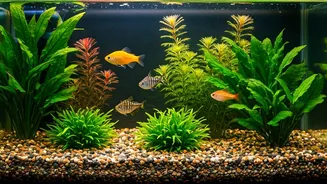Neon Tetra: A Classic Choice
Neon Tetras are a quintessential choice for beginner aquarists due to their vibrant colours and peaceful nature. Originating from the Amazon basin, these
small fish are known for their striking blue and red stripes, adding a burst of colour to any aquarium. They typically grow up to 1.5 inches long, making them suitable for community tanks. Maintaining a stable environment is key, with a temperature range of 21-27°C and slightly acidic water (pH 6.0-7.0) being ideal. They thrive in planted tanks with gentle filtration and benefit from regular water changes. Feeding should include high-quality flake food supplemented with occasional live or frozen foods like brine shrimp or bloodworms. It's recommended to keep them in groups of at least six to reduce stress and allow them to display their schooling behaviour.
Guppy: Hardy and Adaptable
Guppies are incredibly popular among beginners because of their hardiness and ability to thrive in various conditions. These small, colourful fish, known for their prolific breeding, are native to South America. Males display vibrant colours, while females are usually more subdued. They typically reach about 2 inches in length. Guppies can adapt to a wide range of water conditions, but they prefer a temperature between 22-28°C and a neutral pH of around 7.0. They are not overly demanding and do well in planted tanks. They're omnivores and readily accept flake food, supplemented with occasional treats such as daphnia or mosquito larvae. Regular water changes and avoiding overcrowding are essential to keep these fish healthy. They are livebearers, meaning they give birth to live young, which can quickly populate an aquarium.
Mollies: Variety and Elegance
Mollies are another excellent choice for beginners, valued for their variety and elegant appearance. These fish come in various forms, including the popular Sailfin and Lyretail mollies. Native to Central and South America, mollies typically grow up to 4 inches. They thrive in a temperature range of 22-28°C and prefer slightly alkaline water (pH 7.5-8.5), which is easily achievable with aquarium-specific buffers. Mollies are also livebearers and will readily breed in the right conditions. A well-planted tank with good filtration provides a comfortable environment for them. They're omnivores and consume algae as part of their diet, supplementing this with flake food or vegetable matter. Maintaining a clean tank and avoiding drastic water changes helps prevent common diseases in mollies, making them a relatively low-maintenance option.
Zebra Danio: Active and Lively
Zebra Danios are renowned for their lively and active nature, and are very suitable for beginners. Originating from India, these fish are easily recognised by their distinctive stripes, resembling those of a zebra. They're small, typically reaching about 2 inches, and are extremely hardy, adapting well to a variety of conditions. Zebra Danios prefer temperatures between 18-24°C and can tolerate a wide pH range (6.0-8.0). They are ideal for community tanks, and their active swimming behaviour adds dynamism to the aquarium. Danios are not particularly fussy eaters; they readily consume flake food, supplemented by occasional treats like bloodworms or brine shrimp. They thrive in well-oxygenated tanks with plenty of swimming space. Regular water changes and a balanced diet are key to their health and longevity.
Betta Fish: The Siamese Fighter
Betta fish, also known as Siamese fighting fish, are striking in appearance. Native to Southeast Asia, bettas are known for their vibrant colours and flowing fins. Male bettas are particularly beautiful but should be kept singly, as they are aggressive towards other males. They thrive in warmer water, with a temperature range of 24-30°C, and can tolerate a pH between 6.0 and 8.0. Betta fish require a minimum tank size of 5 gallons, and good filtration is essential. They are labyrinth fish, meaning they can breathe from the surface, but a well-oxygenated tank is still important. Betta fish are carnivores and require a protein-rich diet, including betta-specific pellets, bloodworms, and brine shrimp. Regular small water changes are recommended to maintain water quality.













